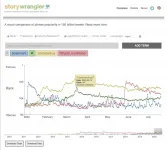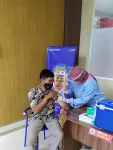(Press-News.org) Researchers at UC San Francisco are zeroing in on how the immune system may play a role in miscarriage, which affects about a quarter of pregnancies.
Working in mice, the researchers have found that a recently discovered subset of cells in the immune system may prevent the mother's immune system from attacking the placenta and fetus. If the research is confirmed in further animal studies, and the cells play a similar role in people, they could point the way toward new therapies for pregnancies that are threatened by defects in immune tolerance.
The researchers showed that pregnant mice who did not have this subset of cells, known as extrathymic Aire-expressing cells, were twice as likely to miscarry, and in many of these pregnancies fetal growth was severely restricted.
"When you're pregnant, the immune system is seeing the placenta for the first time in decades - not since the mother made a placenta when she herself was a fetus," said Eva Gillis-Buck, MD, a UCSF surgery resident and first author of the paper in Science Immunology.
"Our research suggests that this subset of immune cells is carrying out a sort of 'secondary education' - sometimes many years after the better-known population of the educator cells have carried out the primary education in the thymus - teaching T cells not to attack the fetus, the placenta and other tissues involved in pregnancy."
The immune system has to be educated not to attack one's own tissues and organs to prevent autoimmune disease. But pregnancy presents a unique challenge, since the fetus expresses proteins found in the placenta as well as proteins whose genetics are distinct from the mother.
"It was a conceptual leap to link Aire-expressing cells, which are critical for preventing autoimmune disease, to pregnancy," said Tippi Mackenzie, MD, professor of surgery and Co-director of the UCSF Center for Maternal Fetal Precision Medicine and a senior author of the paper. "This work hints at a mechanism for the known association between autoimmune disease and pregnancy complications."
Like the better-known educator cells in the thymus, the rare subset - originally discovered by James Gardner, MD, PhD, an assistant professor of surgery, investigator in the UCSF Diabetes Center, and a senior author of the study - is known for their ability to express a unique protein called the Autoimmune Regulator, or Aire. Aire has been extensively studied in the thymus, where it helps define the curriculum of this "high school" for the immune system.
But the Aire-expressing cells under study reside outside the thymus in the lymph nodes and spleen, so they are called extrathymic Aire-expressing cells, or eTACs. Their role in the immune system is not fully known, although the UCSF scientists suspect they provide a mechanism for "continuing education."
The pregnancy finding is the first evidence that eTACs play a role in the maintenance of normal immune tolerance. In the thymus, Aire-expressing cells begin interacting with other immune cells very early in life to teach them what not to attack. The thymus begins to shrink and is nearly gone by adulthood, by which time most immune cells have been educated.
But as the thymus shrinks, the population of eTACs in lymph nodes and the spleen expands. The study suggests a healthy pregnancy may depend on having these cells around.
To tease apart the normal role of this outlier population of Aire-expressing cells, the researchers used genetically engineered mice from the Gardner lab to delete eTACs selectively during pregnancy.
"Understanding how the immune system normally gets educated to distinguish 'self' from 'non-self' is a very fundamental problem in biology," Gardner said. "Once we know the basic wiring of this self-education system, we hope to do all kinds of powerful things - like modify the curriculum to improve pregnancy outcomes, prevent autoimmunity, or promote tolerance of transplanted organs."
INFORMATION:
About UCSF:
The University of California, San Francisco (UCSF) is exclusively focused on the health sciences and is dedicated to promoting health worldwide through advanced biomedical research, graduate-level education in the life sciences and health professions, and excellence in patient care. UCSF Health, which serves as UCSF's primary academic medical center, includes top-ranked specialty hospitals and other clinical programs, and has affiliations throughout the Bay Area. UCSF School of Medicine also has a regional campus in Fresno. Learn more at ucsf.edu, or see our Fact Sheet.
Follow UCSF
ucsf.edu | Facebook.com/ucsf | YouTube.com/ucsf
UNIVERSITY PARK, Pa. -- From biochemical reactions that produce cancers, to the latest memes virally spreading across social media, simple actions can generate complex behaviors. For researchers trying to understand these emergent behaviors, however, the complexity can tax current computational methods.
Now, a team of researchers has developed a new algorithm that can serve as a more effective way to analyze models of biological systems, which in turn allows a new path to understanding the decision-making circuits that make up these systems. The researchers add that the algorithm will help scientists study how relatively ...
For thousands of years, people looked into the night sky with their naked eyes -- and told stories about the few visible stars. Then we invented telescopes. In 1840, the philosopher Thomas Carlyle claimed that "the history of the world is but the biography of great men." Then we started posting on Twitter.
Now scientists have invented an instrument to peer deeply into the billions and billions of posts made on Twitter since 2008 -- and have begun to uncover the vast galaxy of stories that they contain.
"We call it the Storywrangler," says Thayer Alshaabi, a doctoral student at the University of Vermont who co-led the new research. "It's like a telescope to look -- in real time -- at all this data that people ...
A new method developed by Institute for Systems Biology (ISB) and University of California, Riverside provides new insights into cancer biology by allowing researchers to show how fatty acids are absorbed by single cells.
Fatty acids, along with glucose and amino acids, are a major energy source for cellular growth and proliferation, and abnormal fatty acid metabolism is often seen in cancer. Dr. Wei Wei's lab at ISB and Dr. Min Xue's lab at UC Riverside have been collaborating for years to develop a series of chemical probes and analytical approaches for quantifying cellular glucose uptake, lactate production, amino acid ...
Climate change is driving a large increase in intense, slow-moving storms, a new study by Newcastle University and the Met Office has found.
Investigating how climate affects intense rainstorms across Europe, climate experts have shown there will be a significant future increase in the occurrence of slow-moving intense rainstorms. The scientists estimate that these slow-moving storms may be 14 times more frequent across land by the end of the century. It is these slow-moving storms that have the potential for very high precipitation accumulations, ...
New research published in Nature Medicine reveals willingness to get a COVID-19 vaccine was considerably higher in developing countries (80% of respondents) than in the United States (65%) and Russia (30%).
The study provides one of the first insights into vaccine acceptance and hesitancy in a broad selection of low- and-middle income countries (LMIC), covering over 20,000 survey respondents and bringing together researchers from over 30 institutions including the International Growth Centre (IGC), Innovations for Poverty Action (IPA), WZB Berlin Social Science Center, the Yale Institute for Global Health, the Yale Research Initiative on Innovation and Scale (Y-RISE), ...
Engineers at UC Riverside have unveiled an air-powered computer memory that can be used to control soft robots. The innovation overcomes one of the biggest obstacles to advancing soft robotics: the fundamental mismatch between pneumatics and electronics. The work is published in the open-access journal, PLOS One.
Pneumatic soft robots use pressurized air to move soft, rubbery limbs and grippers and are superior to traditional rigid robots for performing delicate tasks. They are also safer for humans to be around. Baymax, the healthcare companion robot in the 2014 animated Disney film, Big Hero 6, is a pneumatic robot for good reason.
But existing systems for controlling pneumatic soft robots still use electronic valves ...
Imagine an orange cat. Now, imagine the same cat, but with coal-black fur. Now, imagine the cat strutting along the Great Wall of China. Doing this, a quick series of neuron activations in your brain will come up with variations of the picture presented, based on your previous knowledge of the world.
In other words, as humans, it's easy to envision an object with different attributes. But, despite advances in deep neural networks that match or surpass human performance in certain tasks, computers still struggle with the very human skill of "imagination."
Now, a USC ...
BUFFALO, N.Y. - Many legacy media outlets played an unwitting role in the growth of the four most successful fake Twitter accounts hosted by the Russian Internet Research Agency (IRA) that were created to spread disinformation during the 2016 U.S. presidential campaign, according to a study led by a University at Buffalo communication researcher.
In roughly two years beginning in late 2015, these accounts went from obscurity to microcelebrity status, growing from about 100 to more than 100,000 followers. With its heavily populated follower base ready to spread the word -- like all heavily engaged Twitter audiences -- the IRA could strategically deploy messages and provide visible metrics, creating an illusion of authority and ...
As the Covid-19 pandemic raged, news reports show that sales of electronic air cleaners have surged due to concerns about airborne disease transmission. But a research team at the Georgia Institute of Technology has found that the benefits to indoor air quality of one type of purifying system can be offset by the generation of other pollutants that are harmful to health.
Led by Associate Professor Nga Lee "Sally" Ng in Georgia Tech's School of Chemical and Biomolecular Engineering and the School of Earth and Atmospheric Sciences, the team evaluated the effect of a hydroxyl radical generator in an office setting. Hydroxyl radicals react with odors and pollutants, decomposing ...
A team of researchers from the University of Maryland has 3D printed a soft robotic hand that is agile enough to play Nintendo's Super Mario Bros. - and win!
The feat, highlighted on the front cover of the latest issue of Science Advances, demonstrates a promising innovation in the field of soft robotics, which centers on creating new types of flexible, inflatable robots that are powered using water or air rather than electricity. The inherent safety and adaptability of soft robots has sparked interest in their use for applications like prosthetics and biomedical devices. Unfortunately, controlling the fluids that make these soft ...



